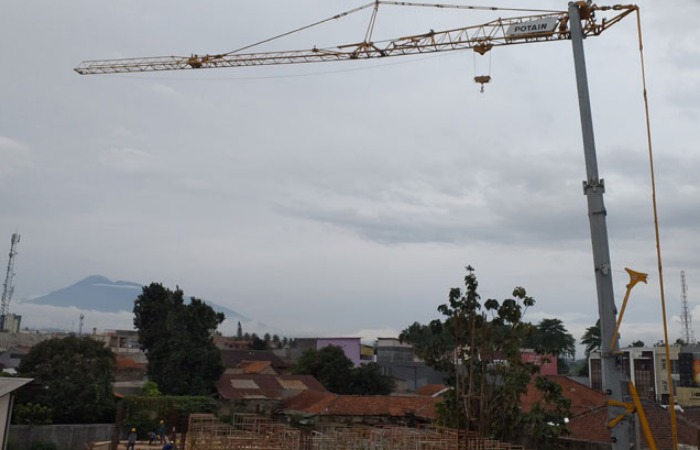
Potain Hup 32-27 continues to win friends & influence equipment choice
Almost five years on from its launch at Bauma 2016, the Potain Hup 32-27 self-erecting crane continues to gain new fans around the world. This acclaim is largely due to its ability to combine typical tower crane operations with replicating many of the tasks performed by smaller, mobile material handling equipment – reducing costs and eliminating excess traffic on jobsites.
One convert to the concept of Potain self-erecting cranes is PT Indonesia Pondasi Raya (Indopora). Founded in 1977, the Jakarta-based contractor is predominantly engaged in piling, retaining walls and ground engineering, for projects as diverse as housing, skyscrapers, underpasses and bridges.
Indopora had traditionally rented conventional tower cranes on larger projects and mobile cranes, rough-terrain forklifts or telehandlers on prefabricated housing projects. But in 2018 the company pursued a new strategy, purchasing a Potain Hup 32-27 on recommendation of Multicrane Perkasa, the local Potain dealer.
The crane proved an immediate hit, and it’s easy to see why. It features an adjustable two-section mast with a third section that can telescope out from the second to increase working height from 21 m to 27 m with the jib in the horizontal position. With a maximum capacity of 4 t, or 1 t at its 32 m jib end, the crane provides even greater versatility with a choice of three luffing positions (10 degree, 20 degree and 30 degree) that increase the maximum under-hook height to 40 m. Folding back the jib to its alternate configurations of 23 m or 11 m is a swift and straightforward process. In total, over 20 separate crane configurations are possible.
Proof positive
The first opportunity for the Hup 32-27 to prove itself to Indopora came with the start of the Eco Home project, a five-story apartment complex in Tangerang, west Java. “The crane was worked hard for a year, lifting precast concrete sections and handling other duties,” says Wahyudi, owner at Indopora. “Its ability to work so well in such a confined location was extremely impressive.”
Key to this ability is the small rear slewing radius of just 2.25 m, enabling the crane to be positioned closer to existing structures. It also offers two compact footprint options of 4 m x 4 m or 3.5 m x 4.42 m. Its innovative, dynamic unfolding movement enables setup in congested areas, while its integrated leveling system compensates for height differentials of up to 25 cm, or gradients of up to 8 per cent.
Next project after the completion of the Eco Home development was the Boxies Mall, another five-story structure in west Bogor, 60 km south of Jakarta. This time the crane was used for about eight months, again lifting precast concrete and other materials.
For such a relatively large crane, the Hup 32-27 becomes surprisingly agile once folded for transportation, packing down to a single 4 m tall, 12 m long package, which again impressed Wahyudi: “We were able to move it quickly from one location to another. It could then be reconfigured rapidly, so the minimal downtime and wider coverage is extremely appreciated.”
The quick setup time of the Hup 32-27 is made possible with Manitowoc’s innovative radio remote control unit. Its Smart Set Up software delivers simplified step-by-step information to the operator via the large, easily navigated color screen and, once setup is completed, provides three operating profiles that vary the working speed to suit the application.
“After three years of use, we are very pleased we made the switch to the Hup 32-27,” concludes Wahyudi. “It has definitely boosted productivity and delivered cost savings, while simplifying the on-site logistics.”
Other Indopora projects where the Hup has proved itself include the Jababeka Living Plaza Mall in Cikarang, and the Indramayu Mall in west Java. And for projects where something a little larger is required, the company can always turn to its MC 310 K12 and MC 465 top-slewing cranes

 +91-22-24193000
+91-22-24193000 Subscriber@ASAPPinfoGlobal.com
Subscriber@ASAPPinfoGlobal.com